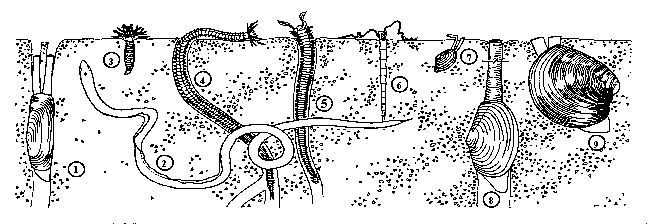What are Benthos?
|
"Benthos" refers to the
benthic invertebrate
community, which is a group of animals that live on or in the bottom sediments
of the Chesapeake Bay. The benthic community includes a wide variety of organisms
including clams, oysters, small shrimp-like crustaceans, and the blood and
clam worms often used as bait.
|
|

|
Topics
|
The following illustration shows a typical healthy benthic
community and includes species characteristic of unstressed communities. In
a polluted environment, these species would be replaced by species more
tolerant of pollution. Most degraded communities would also tend to
have fewer species, fewer large organisms deep in the sediment, and a lower total
mass of organisms. Oysters, mussels, sponges, and barnacles (not shown) are
other examples of benthic organisms which attach to hard surfaces such as
rocks and reefs.

|
A typical "healthy" benthic community |
1 - Stout razor clam (Tagelus plebeius)
2 - Red ribbon worm (Micrura leidyi)
3 - Burrowing anemone (Ceriantheopsis americanus)
4 - Common clam worm (Neanthes succinea)
5 - Red-gilled mudworm (Marenzelleria viridis)
6 - Glassy tube worm (Spiochaetopterus costarum)
7 - Baltic Macoma clam (Macoma balthica)
8 - Soft-shelled clam (Mya arenaria)
9 - Hard clam (Mercenaria mercenaria)
|
|
Below are two sediment profile images (SPI) taken in the Chesapeake
Bay. White scale markings along the side of each image show
1 cm intervals of depth. The black object in the upper center of
each image is a camera artifact, not a sediment feature. (Photos and
interpetation courtesy of Dr. Robert Diaz, VIMS.)
|
|
YR06
is a random bay monitoring site from 1997 in the York River. It shows
good benthic habitat with infaunal activity, deep RPD (Redox Potential
Discontinuity), and light colored sediments. Burrows are larger and
infauna is present. YR06 had a good B-IBI score.
|
YR26
is the same year, another random site in the York River. It shows poor
benthic habitat with gas voids, shallow RPD, dark colored sediments, and
little infaunal activity, just a few small tubes and burrows. YR26
had a bad B-IBI score.
|

|

|
|



